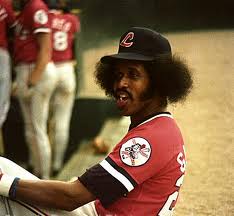 Decades later, Roger was ready with the wisecrack. He retained simple, amusing phrases which also captured a shared memory. His brother laughed when he heard the corny remark again:
Decades later, Roger was ready with the wisecrack. He retained simple, amusing phrases which also captured a shared memory. His brother laughed when he heard the corny remark again:
“Oscar Gamble sure can ramble.”
It had originally been intended as a throwaway line. The comment had been delivered on the air during a Cleveland Indians game in 1974. Harry Jones and Mudcat Grant were playing host to a guest in the broadcast booth at the Stadium, singing and acting legend Bing Crosby. Recuperating from lung surgery, he was as engaging as ever, fully exuding his warm, mellow, 1940s-cool.
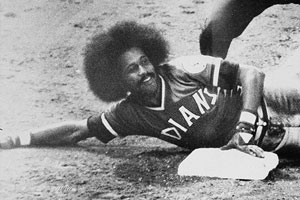 In the midst of Crosby’s gracious stroll down memory lane for the benefit of the viewers, Tribe baserunner Oscar Gamble suddenly caught his attention. Gamble had rounded first base and was hustling towards second. Along the way, his helmet popped off. No longer confined, his eight-inch Afro fully sprang into its relaxed state. It looked a lot like a giant black dandelion which had gone to seed, buffeting in the wind.
In the midst of Crosby’s gracious stroll down memory lane for the benefit of the viewers, Tribe baserunner Oscar Gamble suddenly caught his attention. Gamble had rounded first base and was hustling towards second. Along the way, his helmet popped off. No longer confined, his eight-inch Afro fully sprang into its relaxed state. It looked a lot like a giant black dandelion which had gone to seed, buffeting in the wind.
Gamble was safe at second. And at no time did his hair touch the infield dirt..
Several years earlier, Oscar Gamble had held the promise of excitement as a pro prospect. He’d grown up near Birmingham, Alabama and followed Henry Aaron during his time in Atlanta. The young Gamble also admired Willie Mays in his prime. He originally was a speedy centerfielder who was ‘discovered’ by Chicago Cubs scout Buck O’Neil. (O’Neil was the renowned star of the old Negro Leagues’ Kansas City Monarchs. He scouted and then coached for the Cubs, and had convinced them to select Gamble in the 16th round of the 1968 amateur draft.)
Gamble was called up to the big leagues by the Cubs the very next season. Manager Leo Durocher marveled that the 19 year old was going to be the next Willie Mays. Unfortunately, Gamble suffered from several defensive lapses in the outfield and the Cubs soured on him some. Meanwhile, the Miracle Mets of 1969 steamrolled past the Cubs in the standings and won the pennant. Chicago didn’t ‘blow’ their lead, as much as the Mets caught the proverbial ‘lightning in a bottle’ and overachieved.
During his year-plus in Chicago, he was taken under the wing of Mr. Cub himself, Ernie Banks. Banks, who’d won back-to-back MVP awards as a shortstop in 1958 and 1959, was the first baseman by 1969. Banks looked after the young Gamble. He’d pick him up at the hotel and get him to the game on time, and he kept the young player loose. Soon, however, the Cubs traded Oscar Gamble to the Philadelphia Phillies.
Unconfirmed rumors circulated that Gamble was traded in part because he was said to date white girls. While this may not be the actual reason, its possibility was a sign of the times. Such whispers reportedly affected the willingness of teams to select a player such as Reggie Jackson (whom the Mets passed over in the draft), or to keep on the roster once rumors surfaced (some said Vic Power was traded by the Yankees in a similar shroud of mystery).
The Phillies didn’t give Gamble much of a tryout, either. Notably, however, he was the star of the last game ever played at Connie Mack Stadium (the home of the Phillies prior to the building of Veterans Stadium – The Vet). The stadium seats, which had been mostly empty all season, were packed for the finale. Unruly fans ran onto the field at various points during the game, removing portions of the stadium and the field as keepsakes. In the tenth inning, Gamble singled home catcher Tim McCarver for the winning run, and ran to the clubhouse while trying to avoid the mob.
While in Philadelphia, the left-handed Oscar Gamble was taught the art of getting the bat out in front of the ball and pulling it to right. This made a huge impression on Gamble, who knew that a player could make more money if he hit home runs. The coach who was his hitting instructor at the time was Wally Moses- in his youth, one of the first players ever to appear on a Wheaties cereal box. Moses had Gamble hitting out of an open stance, with both eyes squarely on the pitcher. He twisted his hips to generate power.
In his day, Moses was a ballplayer who was ahead of his time. He was blessed with a great arm, and tremendous speed on the base paths. However, manager Connie Mack insisted that Moses not run at will. So instead, he hit 25 home runs in 1937- a high number for that era. When Moses left Philadelphia, he was encouraged to steal bases, and stole an almost unheard-of 56 bases in 1943. After he retired from playing, Moses was known as a coach who brought out the best in any player: fast or powerful; black or white.
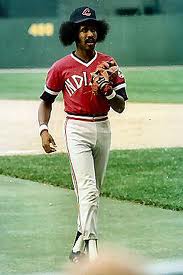 Prior to the 1973 season, Oscar Gamble was sent to the Cleveland Indians. The trade, which began a three-year stint with the Tribe, also saw Del Unser get shipped to the Phillies. While rooming with first baseman Chris Chambliss, and striking up lifelong friendships with players such as Buddy Bell, it was in Cleveland that Gamble began to be considered a solid big-league player. He credits Indians coach Larry Doby with teaching him the nuances of hitting within the strike zone. Doby also showed Gamble how to use his quickness at the plate. Hitting with knees bent, out of a crouch, he averaged 18 home runs per season, platooning with players such as John Ellis as a designated hitter and corner outfielder. As was the case throughout his career, Gamble faced right handed pitching almost exclusively. Yet over his 17yr career, the 5’10”, 165 lb. Oscar Gamble hit 200 home runs in around 4500 at-bats. The 1:22 homer ratio was pretty good, pre-PED.
Prior to the 1973 season, Oscar Gamble was sent to the Cleveland Indians. The trade, which began a three-year stint with the Tribe, also saw Del Unser get shipped to the Phillies. While rooming with first baseman Chris Chambliss, and striking up lifelong friendships with players such as Buddy Bell, it was in Cleveland that Gamble began to be considered a solid big-league player. He credits Indians coach Larry Doby with teaching him the nuances of hitting within the strike zone. Doby also showed Gamble how to use his quickness at the plate. Hitting with knees bent, out of a crouch, he averaged 18 home runs per season, platooning with players such as John Ellis as a designated hitter and corner outfielder. As was the case throughout his career, Gamble faced right handed pitching almost exclusively. Yet over his 17yr career, the 5’10”, 165 lb. Oscar Gamble hit 200 home runs in around 4500 at-bats. The 1:22 homer ratio was pretty good, pre-PED.
Of course, what causes the most interest in Oscar Gamble- to this day- was the huge Afro which complemented the funky ensemble he rocked away from the clubhouse. This was the era of the Charlie O. Finley Oakland A’s, who proudly sported long hair, moustaches and sideburns. Other major leaguers such as Jose Cardenal and Bake McBride also sported large Afros. The high-flying American Basketball Association was known to feature several examples as well.
I was tempted to write this entire piece without one reference to Gamble’s hair. It would have been Andy Kaufman-esque, wouldn’t it? But then, I remembered something my wife once told me: “Greg, you need to remember that sometimes, you are the only one who thinks something is funny.” (And yes, I think that comment is hilarious!)
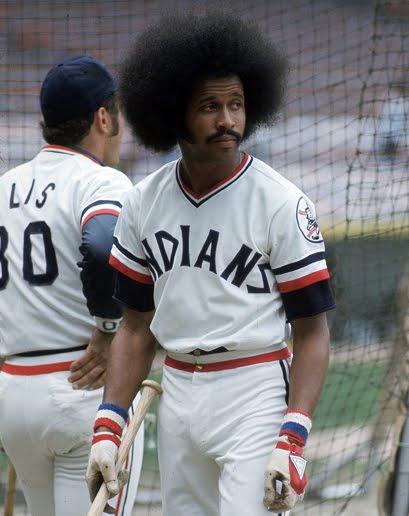 So nobody's hair rivaled that of Oscar Gamble. But again, he had the whole package- clothes, shoes… he was the coolest ballplayer in the major leagues. He even opened his own discotheque, near Birmingham, in 1976. Managed by his three brothers, it was called, “Oscar Gamble’s Players’ Club”.
So nobody's hair rivaled that of Oscar Gamble. But again, he had the whole package- clothes, shoes… he was the coolest ballplayer in the major leagues. He even opened his own discotheque, near Birmingham, in 1976. Managed by his three brothers, it was called, “Oscar Gamble’s Players’ Club”.
Some old-school sportswriters at the time apparently were intimidated to some degree by the pure funk of the man. However, Gamble was noted as being friendly and easygoing by all who knew him. There is some acknowledgement that he was disgruntled over the lack of playing time against left handed pitching; perhaps this is where some of the reporters' reticence came from.
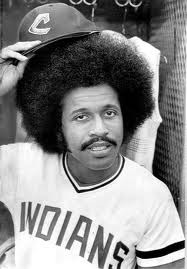 The Indians traded Oscar Gamble to the New York Yankees in a deal which brought pitcher Pat Dobson to Cleveland in return (most of the trades involving Gamble added to a litany of bad airbrush jobs by the good baseball card folks at Topps). Gamble had arranged an endorsement deal with Afro Sheen prior to the trade, but Yankee owner George Steinbrenner insisted if Gamble wanted to be issued a uniform, the hair had to go. Catcher Elston Howard took him to the barber.
The Indians traded Oscar Gamble to the New York Yankees in a deal which brought pitcher Pat Dobson to Cleveland in return (most of the trades involving Gamble added to a litany of bad airbrush jobs by the good baseball card folks at Topps). Gamble had arranged an endorsement deal with Afro Sheen prior to the trade, but Yankee owner George Steinbrenner insisted if Gamble wanted to be issued a uniform, the hair had to go. Catcher Elston Howard took him to the barber.
Gamble enjoyed some success in New York, pulling fly balls into the short right field porch. When the Yankees signed Reggie Jackson as a free agent, Gamble was expendable and was traded to the Chicago White Sox. His hitting continued there, and followed him to his eventual return to New York. During a stop in Texas, he hit .358 (he did not have enough at-bats to qualify for the batting title).
Oscar Gamble remains a fan favorite. He receives several baseball cards a week in the mail, from fans who ask him to sign his autograph and return. He’s also quotable- his most famous line: “They don’t think it be like it is, but it do.”
Proving yet again, Roger, my brother: Oscar Gamble sure could ramble.
Thank you for reading. Next week: Blast From The Past: Bert Blyleven.